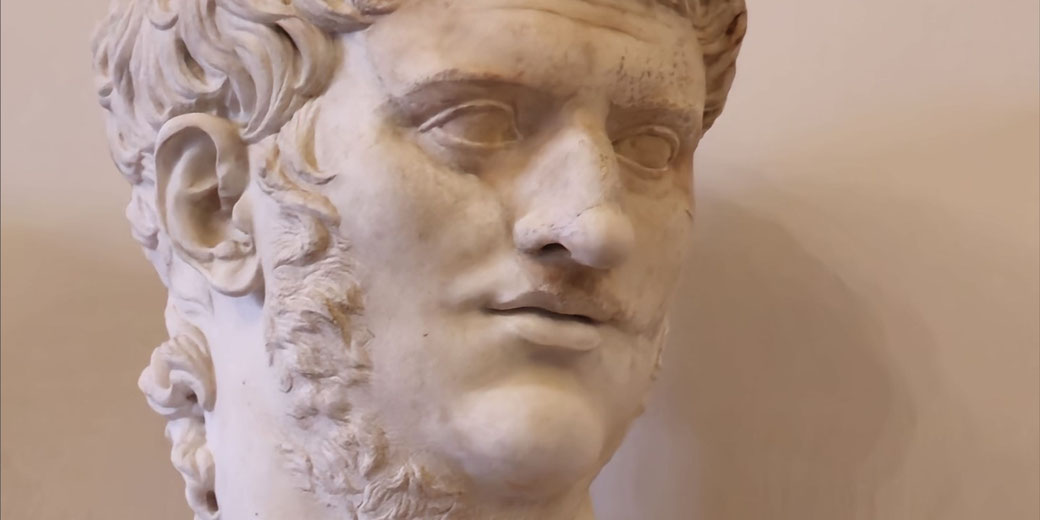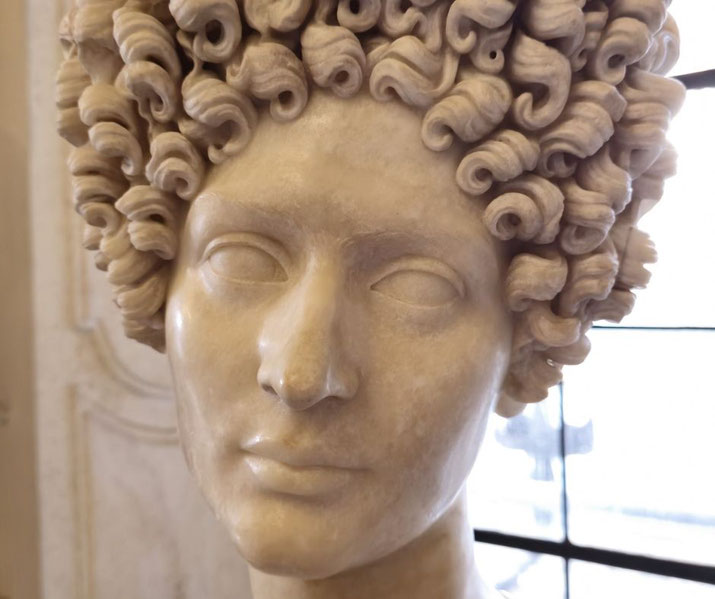Was Nero really Rome's most evil emperor?

Nero was one of the most controversial emperors in Roman history. Some say he was a madman and a tyrant, while others claim that he was simply misunderstood.
No matter what your opinion of him may be, there is no denying that Nero, who ruled as emperor of Rome from AD 54 to 68, was one of the most interesting characters in all of Roman history.
What do we know about Nero's childhood?
Nero was born Lucius Domitius Ahenobarbus on December 15, AD 37, at the coastal Italian town of Antium.
His father was Gnaeus Domitius Ahenobarbus, who was the son of Antonia Major, the daughter of Octavia (emperor Augustus' sister) and Mark Antony. Nero's mother was Agrippina the Younger.
Unfortunately, Nero's father died of an illness when he was just three years old. At the time, Caligula was the emperor of Rome and he exiled Nero's family from Italy for plotting to overthrow him.
As part of this banishment, Nero's inherited land from his father was confiscated by Caligula.
However, following Caligula's assassination in AD 41, Claudius became emperor and Nero's family was allowed to return to Rome.
An important note is that ancient sources describe Nero as having a distinctive appearance with a neck beard, blond hair, and blue eyes.
How Nero was adopted as the imperial heir
In AD 49, his mother, Agrippina, married Emperor Claudius. Nero was only 11 or 12 years old at the time.
However, by the year AD 51, at 14 years old, he began his public life in politics. When he turned 16, Nero was married to Claudius' daughter, Claudia Octavia, strengthening his connection with the imperial dynasty.
During these years, Nero's mother, Agrippina, is claimed to have constantly harassed Claudius to formally adopt Nero as his imperial heir and to declare him as such in his will.
Finally, after consistent nagging, Claudius relented and made the adoption official in AD 50. As a result, Nero had his name changed to Nero Claudius.
In what many modern historians point out as a suspiciously sudden event, Claudius died unexpectedly, soon after the adoption was made public.
This has led many to believe, even ancient Roman historians, that Agrippina had poisoned him.
It may have been that she had been concerned that Claudius could have changed his mind on the adoption, as Claudius' own son, Britannicus, was becoming a popular figure.
Regardless of the cause of Claudius' death, Nero became emperor at the age of 16.
The positive start to Nero's reign
Nero's early years as emperor were generally considered to be a 'golden age'. Under Nero's rule, the arts flourished, and Rome experienced a period of peace and prosperity.
Some modern commentators point to Nero's tutor, and advisor, the famous Stoic philosopher Seneca, as helping to guide the young emperor in his decision making at this time.
He was initially adored by the people, who considered him kind and approachable. There were extravagantly lavish games, plays, concerts, chariot races, and gladiatorial fights, as well as tax reductions.
He also restored a lot of the Roman Senate's power that had been whittled away over time by previous emperors.
However, as his reign continued, Nero started to show his true colors. His tyrannical side began to emerge, and he became increasingly paranoid.
Nero's ongoing conflict with Agrippina
Almost immediately upon taking the throne, Nero's relationship with his mother, Agrippina, was fraught with conflict.
Once he had become emperor, she began trying to manipulate him and rule the empire by using her son as a puppet ruler.
Nero resented her influence and began distancing himself from her. He had her banned from the imperial palace and from attending public events with him.
When Agrippina realised that she no longer had access to power through Nero, she focused her support for Britannicus, the previous emperor's son.
However, Britannicus died unexpectedly while attending a dinner with Nero, and it was widely rumoured that the emperor himself had poisoned him.
This could have been an act by Nero to warn others not to challenge his power, but also to his mother specifically, not to interfere in his affairs.
At some point, Nero decided that his mother was too much of a threat and planned to remove her permanently.
Nero planned the assassination of Agrippina carefully. He tried to install an intricate device in her bedroom ceiling that would collapse and suffocate her in her sleep.
However, it proved to be too complicated to create, and so, he abandoned the idea.
Next, he ordered a special boat be built that would collapse on command and sink. He hoped that by using this, he could kill his mother and make it look like an accident.
However, when Agrippina fell victim to the ploy while sailing one night, she managed to survive and swim safely to shore.
Frustrated with the failure of his elaborate plans, Nero simply ordered his mother to be stabbed to death in AD 59 by one of his former slaves.
Following the death of his mother, Nero's behaviour began to decline, and people began to notice his increasingly negative attitudes more.
People have wondered whether Agrippina had helped keep his behaviour in check while she was alive.
Then, in AD 62, even his advisor, Seneca, retired from public life, and Nero became even more despotic.
Nero's treatment of his wives
Nero's first wife was Octavia, who was very popular with the Roman people.
However, Nero grew to dislike her and began a relationship with another woman, Poppaea Sabina.
In order to marry Poppaea, Nero publicly accused his first wife of unfaithfulness.
He used this to provide justification for his divorce of her, then to have her exiled from Rome and, later, murdered in AD 62.
An additional barrier to Nero's marriage to Poppaea was the fact that she was already married to one of Nero's friends: a man called Marcus Salvius Otho.
To solve this, Nero simply promoted Otho to the position of governor of Lusitania (modern Portugal) and then sent him far away to the borders of the Roman empire.
After Otho's departure, Poppaea divorced him, and she finally married Nero twelve days after the emperor's divorce from Octavia was finalised in AD 62.
However, their marriage was also an unhappy one. While Poppaea was pregnant with Nero's child, she got into an argument with the emperor one night in AD 65.
In anger, Nero kicked her in the stomach, which killed both her and the baby.

The Great Fire of Rome
On 18 July AD 64, a fire broke out in the suburbs of Rome and quickly burnt out of control.
It lasted for six days, during which it destroyed 10 of the 14 city districts and killed hundreds of civilians. Thousands more were left homeless.
Some ancient sources claim that Nero was responsible for the fire, as he wanted to clear space in the crowded city to build a new palace.
To support this, they claim that Nero was seen playing music while the city burned.
However, there is no concrete evidence to support this theory and it is widely believed that Nero was not responsible for the fire.
What is certain, however, is that Nero took advantage of the situation by rebuilding Rome in accordance with his own vision.
Nero's persecution of Christians
To deflect blame for the fire away from himself, Nero used the growing Christian religion as a scapegoat.
He blamed the destruction of the city on the rise of people who did not worship the traditional Roman gods.
As a result, Nero launched a persecution of Christians in Rome. As part of the persecution, Christians were tortured and killed in public spectacles designed to humiliate them.
Some Christians were wrapped in animal skins and torn limb-from-limb, or even covered in flammable tar and burnt alive during Nero's evening dinner parties.
Nero's Golden House
Following the vast destruction caused by the fire, Nero began planning to rebuild the city.
In order to fund various construction projects, Nero raised taxes, which was unpopular.
However, Nero's new designs aimed to improve the city. This included the construction of new residential districts, wider streets, and wide colonnades along streets to improve foot traffic for crowds.
However, the most notorious new building was an expensive new palace for Nero himself. It was so large that it required the size of several city blocks to build.
The palace was so impressive that it was known as the Domus Aurea ("Golden House").
It is said to have had ceilings covered in gold, an artificial lake big enough for boats to sail on, a large garden full of exotic foreign animals, and even a rotating mechanical floor in a dancing hall.
It also featured an enormous statue of himself known as the Colossus of Nero.
To many observers, the Nero appeared to spend more time and money on his palace than on rebuilding Rome and the relief of the people who had been left homeless from the fire.
How did Nero fall?
Nero's vast expenses bankrupted Rome, and many Romans lost patience with the emperor's slow response to rebuilding after the fire.
In AD 65, one senator, called Gaius Calpurnius Piso, led a conspiracy against Nero with the support of a centurion of the praetorian guard.
These men wanted to free Rome from an emperor who they believed would ultimately destroy the empire.
However, Piso's conspiracy was reported to Nero. The emperor had the ringleaders arrested and executed including the famous poet, Lucan.
Seneca, Nero's retired advisor, was accused of being involved and was ordered to commit suicide by Nero himself.
Nero may have hoped that his swift and harsh response to the conspiracy may have discouraged others from doing the same, but this was not the case.
In AD 68, two different governors, from two different provinces rose up in revolt: Vindex in Gaul, and Galba in Spain.
When word of the revolts reached Spain, Nero was able to dispatch an army to defeat Vindex, but Galba's revolt spread.
The Senate finally declared Nero to be a 'public enemy' in the same year and declared their support for Galba.
Also, the prefect of the praetorian guard, Sabinus, also abandoned the emperor in favour of Galba.
By that stage, Nero realised that he had lost the support of the people, Senate and the praetorian guard, and decided to flee from Rome.
Dressed in a disguise, he took a horse and was able to reach the villa of one of his freedmen outside the city, but was surrounded by soldiers who were sent to find him.
In a panic, Nero attempted to commit suicide. However, his attempt failed, and he needed his most trusted secretary, a former slave that had been freed, named Epaphroditus, to finish the job for him.
As the emperor lay dying, one of the centurions pursuing him entered the house and tried to stop the bleeding by using his own cloak.
However, he was too late to make any difference. So, Nero died on the 9th of June AD 68, at the age of 30.
He was the last of the Julio-Claudian dynasty of emperors, which had started with Augustus.
Unfortunately for the Romans, the death of Nero did not bring peace nor security. Instead, it would begin the 'year of the four emperors', where a succession of military commanders fought each other for the imperial throne.
The empire was condemned to much greater death and chaos than it was used to under the previous emperors.
Further reading
What do you need help with?
Download ready-to-use digital learning resources
Copyright © History Skills 2014-2025.
Contact via email
With the exception of links to external sites, some historical sources and extracts from specific publications, all content on this website is copyrighted by History Skills. This content may not be copied, republished or redistributed without written permission from the website creator. Please use the Contact page to obtain relevant permission.





